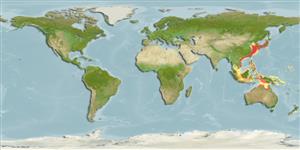Teleostei (teleosts) >
Callionymiformes (Dragonets) >
Callionymidae (Dragonets)
Etymology: Callionymus: Greek, kallion, comparative of kallos = beautiful + Greek, onyma = name; with a better name .
More on author: Valenciennes.
Environment: milieu / climate zone / depth range / distribution range
Ecology
Marine; freshwater; brackish; demersal. Subtropical
Northwest Pacific.
Size / Weight / Age
Maturity: Lm ? range ? - ? cm
Max length : 20.4 cm TL male/unsexed; (Ref. 112063); max. published weight: 33.90 g (Ref. 112063)
Inhabits shallow sandy bottoms of bays (Ref. 43239).
Life cycle and mating behavior
Maturities | Reproduction | Spawnings | Egg(s) | Fecundities | Larvae
Wu, H.-L., 1991. Callionymoidei. p. 417-422. In J.-H. Pan, L. Zhong, C.-Y. Zheng, H.-L. Wu and J.-H. Liu (eds). 1991. The freshwater fishes of Guangdong Province. Guangdong Science and Technology Press, Guangzhou. 589 pp. (Ref. 33468)
IUCN Red List Status (Ref. 130435)
Threat to humans
Harmless
Human uses
Tools
Special reports
Download XML
Internet sources
Estimates based on models
Preferred temperature (Ref.
123201): 15.2 - 27, mean 21.8 °C (based on 199 cells).
Phylogenetic diversity index (Ref.
82804): PD
50 = 0.5000 [Uniqueness, from 0.5 = low to 2.0 = high].
Bayesian length-weight: a=0.00794 (0.00432 - 0.01461), b=2.72 (2.56 - 2.88), in cm total length, based on LWR estimates for this species & Genus-body shape (Ref.
93245).
Trophic level (Ref.
69278): 3.2 ±0.40 se; based on food items.
Resilience (Ref.
120179): Medium, minimum population doubling time 1.4 - 4.4 years (Preliminary K or Fecundity.).
Fishing Vulnerability (Ref.
59153): Low vulnerability (10 of 100).
